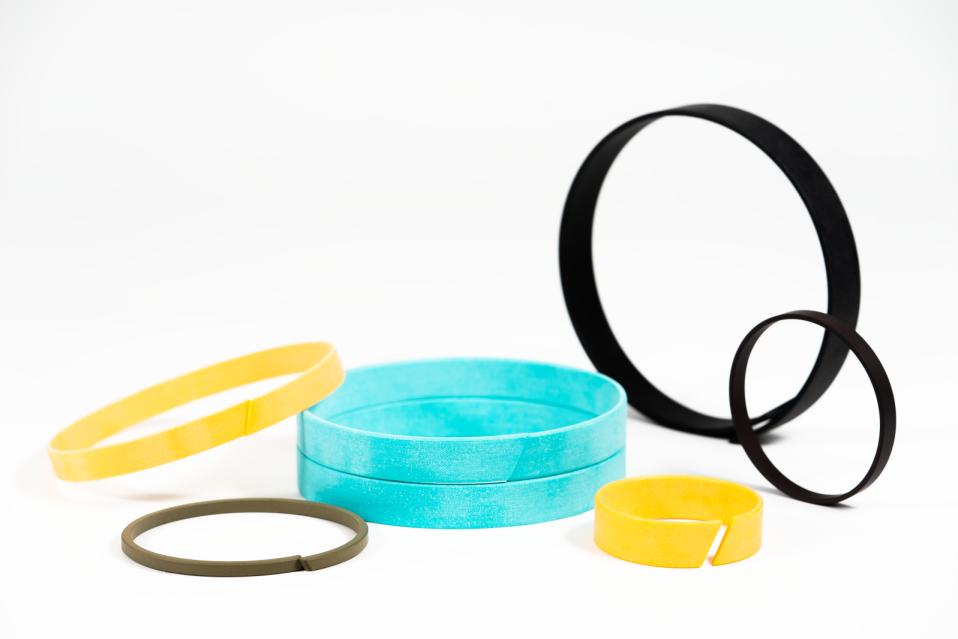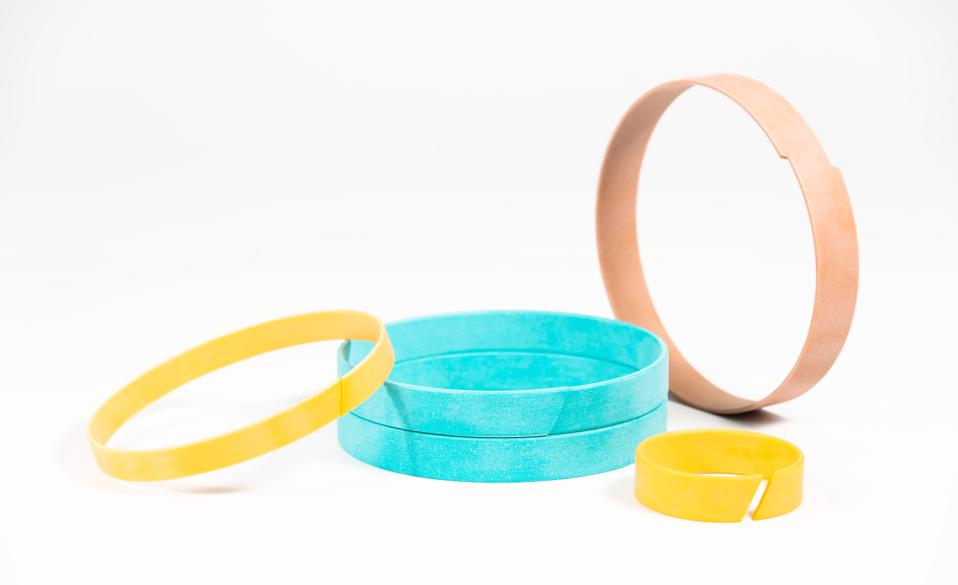Industrial machinery forms the foundation of various sectors, playing a crucial role in driving global economic expansion. As highlighted in a MarketsandMarkets report, the industrial machinery market is anticipated to grow to USD 793.5 billion by 2025, with a compound annual growth rate (CAGR) of 5.3% from 2020 to 2025. Essential to the durability and effectiveness of these machines are wear components, which endure the rigors of friction and operational demands. Among these components, fabric wear rings are particularly significant. Crafted from robust composite materials, these rings minimize metal-to-metal contact, thereby ensuring smoother machine operation and extending equipment lifespan. By reducing wear and tear, fabric wear rings not only enhance performance but also contribute to lowering maintenance expenses, solidifying their essential role in industrial settings.
Understanding Fabric Wear Rings
Hydraulic Wear Rings and Guide Rings
In hydraulic cylinders, wear rings and guide rings play a crucial role. These components guide the hydraulic cylinder piston and rod, absorbing lateral forces to prevent metal-to-metal contact between moving parts, such as between the piston and the cylinder or the rod and the cylinder head. Hydraulic wear rings come in various materials, including phenolic resin fabric (WR), POM (WR), and nylon (WR), while guide rings are made from PTFE bronze and POM. JSPSEAL, a hydraulic seals factory in China, produces best-selling hydraulic wear rings and guide rings compatible with brands like CATERPILLAR, JOHN DEERE, VOLVO, and KOMATSU. Their JSPWR hydraulic wear rings, notable for high toughness, good water absorption, and affordability, include a specialized version for Sany and XCMG with high-temperature resistance up to 250°C, double that of standard phenolic resin materials, suitable for heavy loaders and available in sizes from 20-1400mm.
Definition and Basic Function in Industrial Settings
Fabric wear rings are essential components in industrial machinery, serving as guides for moving parts within hydraulic cylinders and other mechanical systems. Their primary function is to prevent direct metal-to-metal contact, reducing friction and wear between components. This guidance helps maintain the alignment of pistons and rods, ensuring smooth and efficient operation of the machinery. By absorbing lateral forces, wear rings also protect the cylinder from potential damage caused by misalignment or excessive load.
Types of Materials Used in Fabric Wear Rings
Fabric wear rings are made from a variety of materials tailored to specific industrial applications. Common materials include polymers such as POM (polyoxymethylene) and composites like phenolic resin fabric. These materials are chosen for their durability, low friction properties, and ability to withstand high loads and harsh environmental conditions. Advanced materials like PTFE (polytetrafluoroethylene) bronze composites are also used, offering superior self-lubricating properties and resistance to wear.
Importance of Material Selection Based on Application and Environmental Factors
Selecting the appropriate material for fabric wear rings is critical to their performance and longevity. Factors such as the operating environment, load capacity, temperature range, and exposure to chemicals and fluids must be considered. For instance, phenolic resin fabric is suitable for applications requiring high mechanical strength and water absorption, while PTFE bronze composites are ideal for high-temperature environments and applications needing excellent sliding properties. Proper material selection ensures that the wear rings can withstand the specific demands of their application, providing reliable performance and reducing maintenance costs.
Key Benefits of JSPSEAL's Fabric Wear Rings
Avoid Direct Contact Between Metal Parts
JSPSEAL's fabric wear rings are designed to prevent direct metal-to-metal contact, reducing friction and wear between moving parts. This protection extends the life of the machinery and enhances operational efficiency.
Dimensional Stability and Vibration Absorption
The wear rings are dimensionally stable and effectively absorb vibrations, ensuring smooth operation and minimizing the risk of component misalignment or damage.
Self-Lubricating and Good Sliding Properties
JSPSEAL's wear rings are self-lubricating, offering excellent sliding properties that reduce friction and wear. This feature is particularly beneficial in applications where lubrication may be challenging.

High Wear Resistance and Long Service Life
Made from durable materials, these wear rings boast high wear resistance, ensuring a long service life even in demanding industrial environments.
Resistance to Fluids and Chemicals
The wear rings are resistant to most fluids and chemicals, making them suitable for various industrial applications where exposure to harsh substances is common.
High Load Capability
JSPSEAL's wear rings are capable of withstanding high loads, providing reliable performance in heavy-duty applications.
Simple Closed Groove and Easy Installation
The design of these wear rings allows for simple closed groove installation, making them easy to install and replace, thus reducing downtime.
Low Service Costs
The durability and reliability of JSPSEAL's wear rings result in lower service costs, as they require less frequent replacement and maintenance, contributing to overall cost savings for industrial operations.
Applications Across Industries
Automotive Manufacturing
Fabric wear rings are essential in automotive manufacturing to ensure smooth operation of assembly line machinery. These rings guide and support moving parts like pistons and rods in hydraulic systems, preventing metal-to-metal contact and minimizing wear. In processes such as automotive stamping and molding, fabric wear rings maintain tool and die alignment, crucial for producing high-quality car components. Their durability and resistance to wear make them invaluable in high-volume production environments, enhancing efficiency and reliability across automotive manufacturing operations.
Heavy Machinery and Equipment
In heavy machinery and large-scale equipment, fabric wear rings play a critical role within hydraulic systems. Used extensively in mining, construction, and agriculture, these rings absorb lateral forces and guide moving parts, thereby improving machinery durability and performance. By reducing friction and preventing metal-to-metal contact, fabric wear rings extend equipment lifespan, reduce downtime, and lower maintenance costs. This makes them indispensable for ensuring reliable operation under challenging conditions in heavy industries.
Industrial Pumps and Compressors
Fabric wear rings are indispensable in industrial pumps and compressors to maintain fluid dynamics and pressure stability. These rings ensure proper alignment of pistons and moving parts, minimizing friction and wear. By facilitating smooth and stable operation, fabric wear rings enhance efficiency and performance in pump and compressor systems. They are commonly found in applications such as centrifugal pumps and reciprocating compressors, where their ability to withstand high pressures and harsh chemicals is crucial. From chemical processing to water treatment, fabric wear rings contribute to the reliability and longevity of critical industrial equipment.
Innovations and Future Trends
Advances in Fabric Wear Ring Technology
The evolution of fabric wear ring technology focuses on enhancing performance and durability through advanced materials and manufacturing techniques. New composite materials offer superior wear resistance, lower friction coefficients, and increased load capacities. These materials are engineered to withstand extreme environments, including high temperatures and corrosive conditions, broadening the scope of fabric wear ring applications across industries. Improved manufacturing processes ensure precision and consistency in fabric wear ring production, optimizing their fit and functionality in diverse industrial settings.
Potential for Integrating IoT and Sensor Technologies for Predictive Maintenance
Future trends in fabric wear rings include integrating IoT (Internet of Things) and sensor technologies for predictive maintenance. Embedded sensors can monitor wear levels and performance metrics in real-time, enabling proactive maintenance interventions. By predicting potential issues before they escalate, IoT-enabled fabric wear rings help extend machinery lifespan, minimize downtime, and reduce maintenance costs. This technological integration revolutionizes maintenance practices, enhancing operational efficiency and reliability in industrial applications.
Environmental Considerations and Sustainability Trends in Material Choices
Sustainability is influencing material choices for fabric wear rings, driven by environmental concerns and industry regulations. Manufacturers are exploring eco-friendly materials such as recycled composites and biodegradable polymers. Greener manufacturing processes aim to reduce carbon footprints and promote resource-efficient production. By prioritizing sustainability, the industry addresses environmental impact while meeting the demand for eco-conscious solutions in industrial applications. These efforts contribute to a more sustainable future and align with global initiatives for responsible resource management.
In Sum
Fabric wear rings play a crucial role in enhancing the efficiency and durability of industrial machinery. They guide and support moving parts, preventing metal-to-metal contact, reducing friction, and minimizing wear. This ensures smooth operation across diverse applications, including automotive manufacturing, heavy machinery, and industrial pumps. Ongoing advancements in materials and the integration of IoT for predictive maintenance are transforming their capabilities. Additionally, the adoption of sustainable materials underscores a commitment to environmental responsibility. In conclusion, fabric wear rings are essential for maintaining high performance, lowering maintenance costs, and fostering sustainability in industrial operations.

